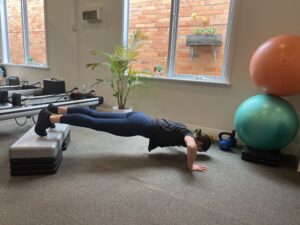Strength & Conditioning
When it comes to rehabilitation for an injury – luckily physiotherapists can simplify what exercises you need to do, how many repetitions & sets you should do, and how frequently you should perform your exercises for optimum effect.
We often can start strength training a lot earlier in your recovery than you expect.
In this blog we are going to clarify the different types of strength exercises that you may be prescribed. Some of which may sound familiar if you have had a past injury & carried out a structured rehab program with a physio.
Types of strength exercises:
Isometric: Contracting a muscle against a force without the muscle changing length i.e staying
in a fixed position. An example is a wall squat hold for 30 secs. This form of strengthening is
good within the early phase of recovery to maintain strength & create nervous system changes.
Eccentric: These exercises are when the muscle is working against load whilst it is
lengthening. For example during a push up you may push yourself away from the ground for 1
Concentric: Concentric exercises involve working against load as the muscle shortens. A good
example of this is a bicep curl when you curl from a straight elbow to a bent position taking the
biceps muscle to its shortest length. These exercises are used later on in rehab once out of the
acute phase in order to strengthen the muscles throughout their range of motion.
All types of strength exercises have their place and allow us to move onto the next phase of
rehab feeling stronger. Once you have mastered strengthening a single muscle group in
isolation, then it is important to make your exercises more functional by bringing in multiple
joints and muscles working together in one movement e.g. squats.
The optimum prescription for strength based training includes:
3-5 RM (repetition maximum)
5-9 sets per week (so this might look like 3 sets of an exercise, 3x/week)
Minimum 4-weeks, aiming for 8-12 weeks
The importance of progressing or regressing your exercises:
In order to strengthen a specific muscle group over time we must apply the principle of overload.
This involves us over time slowly increasing the demand of an exercise or movement on the
given muscle group(s) in order to maintain a strength stimulus. This results in us becoming
stronger, faster, more resistant to fatigue, and ultimately reduce the likelihood of injury!
The ways in which we may change up or progress your strength program include changing the
load or weight of the exercise, changing the speed of the movement, or changing the joint angle
or range of movement that we are using to name a few.
Having a physiotherapist monitor your strength-based program, run through appropriate
progressions with you, and ensure you are maintaining correct form throughout is extremely
important in order to strengthen without aggravating the tissue structure or joint that we are
rehabilitating. Gone are the days of rest & hoping that the injury will settle down on its own only
to find that it flares back up 2 months later!!
If you are suffering from an injury either acute or chronic, have noticed a specific area of
weakness or are unsure on where to start on your strength or exercise journey then give us a
Alternatively, you can book directly online for an Initial Assessment with one of our
physiotherapists.
Blog written by Physiotherapist, Laura Cook




